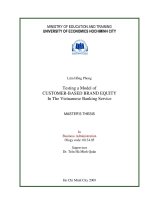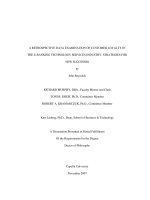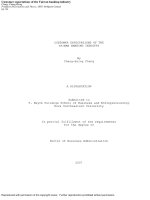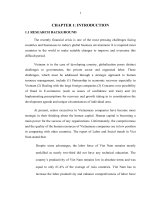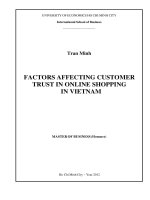Factors affecting customer loyalty in the vietnamese banking industry
Bạn đang xem bản rút gọn của tài liệu. Xem và tải ngay bản đầy đủ của tài liệu tại đây (1.54 MB, 77 trang )
UNIVERSITY OF ECONOMICS HO CHI MINH CITY
International School of Business
------------------------------
Tran Nguyen Anh Tuan
FACTORS AFFECTING CUSTOMER
LOYALTY IN THE VIETNAMESE
BANKING INDUSTRY
MASTER OF BUSINESS (Honours)
Ho Chi Minh City – Year 2014
UNIVERSITY OF ECONOMICS HO CHI MINH CITY
International School of Business
------------------------------
Tran Nguyen Anh Tuan
FACTORS AFFECTING CUSTOMER
LOYALTY IN THE VIETNAMESE
BANKING INDUSTRY
ID: 22110077
MASTER OF BUSINESS (Honours)
SUPERVISOR: DINH THAI HOANG
Ho Chi Minh City – Year 2014
ABSTRACT
With a population of 91 million consumers and economic growth rate averaged 6.57 percent
from 2006 until 2012, Vietnam has been an attractive foreign investment destination. Therefore,
the competition has been gradually increasing. Banking industry is no exception as it has high
interaction with the customers, so managers have to understand the factors which influence the
loyalty of customers towards their respective banks. According to Afsar et al., (2010), “it is
always costly to attract new customers, so the managers always try to find ways to retain their
current customers and focus on different factors which enhances the customer loyalty among the
customers of the organizations”.
Based on that, the study was carried out to reveal the impact of corporate image, service quality,
customer satisfaction, switching cost and trust on customer loyalty in the Vietnamese banking
industry.
This study gathered survey data from a convenience sample of 252 consumers are living and
working in Ho Chi Minh City. The results demonstrate that corporate image, customer
satisfaction and switching cost have positive relationships with customer loyalty. The
relationships of these factors are studied and the SPSS software is used to analyze the data
gathered from the respondents.
i
ACKNOWLEDGMENTS
I would like to express my sincere thankfulness to my research advisor, Prof. Dinh Thai Hoang
for his support throughout the research process. He had devoted his valuable time and efforts in
patiently guiding me to complete this study. I would like to convey my special thanks to him for
his assistance and encouragement.
I would like to express my gratitude to all ISB staffs that supported necessary materials and
helped summit my papers. Especially, I would like to give my special thanks my family for
supporting me spiritually throughout my life.
I thank my friends and colleagues who provided much needed inspiration and support during this
time.
Ho Chi Minh City, Viet Nam
Tran Nguyen Anh Tuan
ii
TABLE OF CONTENTS
Abstract .................................................................................................................................. i
Acknowledgments ................................................................................................................... ii
Tables of content ..................................................................................................................... iii
List of tables ........................................................................................................................... vi
List of figures .......................................................................................................................... vii
Chapter 1: Introduction ........................................................................................................... 1
1.1 Background ....................................................................................................................... 1
1.2 Research problem .............................................................................................................. 2
1.3 Research questions ........................................................................................................... 2
1.4 Research delimitations....................................................................................................... 3
1.5 Contribution of the research .............................................................................................. 3
1.6 Outline of study................................................................................................................. 3
Chapter 2: Literature review .................................................................................................... 5
2.1 Customer loyalty ............................................................................................................... 5
2.2 Factors affecting customer loyalty ..................................................................................... 6
2.2.1 Customer satisfaction ..................................................................................................... 6
2.2.2 Trust ............................................................................................................................... 7
2.2.3 Service quality................................................................................................................ 7
2.2.4 Switching cost ................................................................................................................ 8
2.2.5 Corporate image ............................................................................................................. 9
2.3 Research model and hypotheses ........................................................................................ 9
Chapter 3: Research method .................................................................................................... 12
iii
3.1 Research process ............................................................................................................... 12
3.2 Measurement scale ............................................................................................................ 14
3.2.1 Customer loyalty ............................................................................................................ 14
3.2.2 Corporate image ............................................................................................................. 14
3.2.3 Perceived service quality ................................................................................................ 14
3.2.4 Customer satisfaction ..................................................................................................... 15
3.2.5 Switching cost ................................................................................................................ 16
3.2.6 Trust ............................................................................................................................... 16
3.3 Measurement refinement ................................................................................................... 16
3.3.1 Qualitative research ........................................................................................................ 17
3.3.2 Quantitative pilot research .............................................................................................. 17
3.4 Sample and date collection ................................................................................................ 18
3.4.1 Sample size .................................................................................................................... 18
3.4.2 Sampling ........................................................................................................................ 19
3.4.3 Data analysis methods .................................................................................................... 19
Chapter 4: Data analysis and results ........................................................................................ 22
4.1 Pilot study ......................................................................................................................... 22
4.1.1 Cronbach’s alpha ............................................................................................................ 22
4.1.2 Exploratory factor analysis ............................................................................................. 23
4.2 Main survey ...................................................................................................................... 26
4.2.1 Descriptive analysis ........................................................................................................ 26
4.2.2 Cronbach’s alpha ............................................................................................................ 28
4.2.3 Exploratory factor analysis ............................................................................................. 28
iv
4.2.4 Regression analysis ........................................................................................................ 30
Chapter 5: Conclusion and implications .................................................................................. 36
5.1 Conclusion ........................................................................................................................ 36
5.2 Managerial implications .................................................................................................... 36
5.3 Limitations of study and future research ............................................................................ 38
References .............................................................................................................................. 40
Appendices ............................................................................................................................. 43
Appendix 1: Questionnaire ...................................................................................................... 43
Appendix 2: Reliability analysis in Pilot study ........................................................................ 49
Appendix 3: EFA result of service quality in pilot study .......................................................... 53
Appendix 4: EFA result of the remaining variables in pilot study ............................................ 55
Appendix 5: Descriptive analysis ............................................................................................ 58
Appendix 6: Reliability in main study ..................................................................................... 59
Appendix 7: EFA result of service quality in main study ......................................................... 61
Appendix 8: EFA result of the remaining variables in main study ........................................... 63
Appendix 9: Partial regression plot ......................................................................................... 65
Appendix 10: Homoscedasticity of residuals ........................................................................... 67
Appendix 11: Charts of residual normality .............................................................................. 68
v
LIST OF TABLES
Table 3.1: Scales of customer loyalty
Table 3.2: Scales of corporate image
Table 3.3: Scales of perceived service quality
Table 3.4: Scales of customer satisfaction
Table 3.5: Scales of switching cost
Table 3.6: Scales of trust
Table 4.1: Summarized EFA analysis for Service quality in pilot study
Table 4.2: Summarized EFA analysis of the remaining variables in pilot study
Table 4.3: Service characteristics
Table 4.4: Summarized EFA analysis for Service quality in main survey
Table 4.5: Summarized EFA analysis for the remaining variables in main survey
Table 4.6: Correlations
Tables 4.7: Coefficients
Table 4.8: Model summary and ANOVA
Table 4.9: Summary of Hypotheses testing results
vi
LIST OF FIGURES
Figure 2.1: A conceptual model
Figure 3.1: Research process
Figure 4.1: A revised model
vii
CHAPTER 1
INTRODUCTION
This chapter introduces the background and problems of the research. It then shows the research
questions that are needed to answer. It also reviews the contribution and the structure of the
research.
1.1 Background
During the past decade, the financial services sector has undergone drastic changes, resulting in a
market place which is characterized by intense competition, little growth in primary demand and
increased deregulation. In the new market place, the occurrence of committed and often inherited
relationships between a customer and his or her bank is becoming increasingly scarce (Levesque
& McDougall, 1996). Banking industry has traditionally operated in a stable environment for
decades. Today, this industry is facing fierce competition for market share. Indeed, Huong Tra
(2013) stated, “Currently the retail market has witnessed fierce competition from banks in Viet
Nam. Although this industry has developed in the early stages, it has been contributing
significantly to the economic growth of the country. On average, the contribution of retailers to
GDP is about 14% each year. By 2014, the sector’s contribution to GDP will increase to 23%”.
Banks begin to realize that no bank can offer all products as every bank is trying hard to retain
their existing customers with all sorts of innovation in their product. According to Afsar et al.,
(2010), “it is always costly to attract new customers, so the managers always try to find ways to
retain their current customers and focus on different factors which enhances the customer loyalty
among the customers of the organizations”. Tariq and Moussaoui (2009) stated that “a loyal
customer generally behaves better than a satisfied one and prefers to repurchase the products and
1
services continuously to an extent that her patronage is retained for a long period of time”
(p.102).
1.2 Research Problem
Retail banking sector in Vietnam is characterized by increased competition. In “Vietnam
commercial banking Report Q2 2013” (2013), the researchers stated that “The State Bank of
Vietnam identifies six 'state-owned credit institutions' or 'state-owned commercial banks'
(SOCBs), 38 urban commercial joint stock banks (CJSBs), 32 branches of foreign banks and five
joint venture banks. There are also 17 finance companies and 54 representative offices of foreign
banks” (page 30). With the foreign banks entering the market, competition in the banking sector
has become more intense because both domestic and foreign banks fight for new customers. As a
customer’s relationship with the company lengthens, profit rises. Indeed, Reichheld and Sasser
(1990) stated, “companies can boost profits by almost 100% by retaining just 5% more of their
customer” (p. 2).
In comparison with Vietnamese banks, foreign banks have better infrastructure, provide more
professional customer service, use more advanced technology, and have a network across many
countries. Therefore, managers at Vietnamese banks must understand the factors which influence
the loyalty of the customers towards their respective banks.
Due to the facts mentioned above, it is necessary to explore the factors that determine customer
loyalty to retain and attract customer. This study is conducted to identify the factors affecting
customer loyalty in banking industry of Vietnam. Therefore, it also helps the banks make
decisions in order to selecting the most appropriate strategies for their goals.
1.3 Research Questions
2
The aim of this research is to identify the factors affecting customer loyalty and to determine the
influence of each factor on the loyalty of customer in the Vietnamese banking industry. This
study attempted to answer the following research questions:
-
What factors affect the customer loyalty in banking sector of Vietnamese?
-
How is the relationship between these factors and customer loyalty in banking industry?
Which will influence customer loyalty the most?
1.4 Research delimitations
This study focuses on individual customers in Ho Chi Minh City, who use personal banking
services of different banks. Therefore, this sample cannot represent the whole Vietnam. In
addition, there are five factors including corporate image, service quality, customer satisfaction,
switching cost and trust are considered as the antecedents of customer loyalty.
1.5 Contribution of the research
This research tries to present the factors which influence customer loyalty in the context of
Vietnamese banking industry. As it was mentioned previously in this research, loyal customers
have different benefits for the industries and banking industry is no exception. Having more
profit is the simplest way to mention. Therefore, managers can consider these findings in their
business strategies in the future. Especially with the transitional market as Vietnam, the more
understanding what factors impact on customer loyalty, the more successful the bank received
when apply appropriately.
1.6 Outline of study
This research will be composed of 5 Chapters:
Chapter 1: Introduction to introduce research background, research problem, research question as
well as research objective.
3
Chapter 2: Literature review. This chapter reviews theories and previous study, then formulates
the research model and hypotheses.
Chapter 3: Research methodology. This chapter provides general idea how the research will be
designed and implemented.
Chapter 4: Data analysis, result and finding discussion. This chapter translates data collected
from survey, analyses data and discusses the result finding relating to theory.
Chapter 5: Conclusion, implications, limitation. This chapter concludes the research findings;
provide further suggestion as well as research limitation.
4
CHAPTER 2
LITERATURE REVIEW
This chapter is an overview of customer loyalty and its factors which have been conducted by
previous researchers. Based on these studies, a conceptual model is proposed.
2.1 Customer loyalty
There has been much interest in the marketing literature in the concept of customer loyalty, such
as loyalty to a brand, product or service. Customer loyalty is defined as those who repeat
purchase from the same service provider and show a good impression towards the relationships
with that service provider (Grembler and Brown, 1996, as cited in Cuong, Sirion & Howard,
2009, p.90). Customer loyalty means that the customer is loyal to the company and only turns to
a competitor in exceptional cases. If the customer value decreases to such a level that offers from
competitors are better, customers would engage in the others instead.
Dick and Basu (1994) stated that “customer loyalty is viewed as the strength of the relationship
between an individual’s relative attitude and repeat patronage” (p.99). In a similar way, Oliver
(1997, p.392; as cited in Donio', Massari, and Passiante, 2006, p.446) defined customer loyalty
as: “a deeply held commitment to re-buy or re-patronize a preferred product/service consistently
in the future, thereby causing repetitive same-brand or same brand-set purchasing, despite
situational influences and marketing efforts having the potential to cause switching behavior”.
Beerli et al., (2004) distinguished two types of customer loyalty concepts:
(1) loyalty based on inertia, where a brand is bought out of habit merely because this take
less effort and the consumer will not hesitate to switch to another brand if there is some
convenient reason to do so; and
5
(2) true brand loyalty, which is a form of repeat purchasing behavior reflecting a conscious
decision to continue buying the same brand, and it must be accompanied by an
underlying positive attitude and a high degree of commitment toward the brand. (para.5)
“Inertia means when the consumer is buying the products from the same brand, not because of
true brand loyalty, but because it is not worth their time and efforts to search for an alternative”
(Beerli et al, 2004, p.255). It is rather easily for the competitor to change a buying pattern and
attract new customers. If the usual brand is out of stock, another similar brand will be purchased.
Besides it, brand loyalty measured by repeat purchase is the result of repeated satisfaction that in
turn leads to weak commitment because there is some convenient reason for customers to switch
to another brand.
In relation to true brand loyalty, Oliver (1999) considers that “all three decision-making phases
must point to a focal brand preference if true brand loyalty exists. Thus, (1) the brand attribute
ratings (beliefs) must be preferable to competitive offerings, (2) this "information" must coincide
with an affective preference (attitude) for the brand, and (3) the consumer must have a higher
intention (conation) to buy the brand compared with that for alternatives.” (p.35). Compared to
an inertia situation where the customer passively accepts a brand, a true brand loyal customer
chooses actively with his or her favorable attitude.
In short, customer loyalty is one of the most important issues of the firms. Loyal customers not
only increase the value of the business, but they also enable it to maintain costs lower than those
associated with attracting new customers (Barroso Castro and Martin Armario, 1999, as cited in
Beerli et al., 2004).
2.2 Factors affecting customer loyalty
2.2.1 Customer satisfaction
6
Customer satisfaction is one of the most important concepts for most marketers and consumer
researchers (Jamal, 2004; as cited in Cuong, Sirion & Howard, 2009). The conceptualization of
customer satisfaction is very complex and has been defined in many different situations.
According to Jamal and Naser (2002), customer satisfaction is the feeling or attitude of a
customer towards a product or service after it has been used. Satisfied customers will continue to
purchase, and dissatisfied customers will stop purchasing the product. Levesque and McDougall
(1996) confirmed and reinforced the idea that unsatisfactory customer “had a significant and
dramatic drop in customer satisfaction, willingness to recommend to friend, and, conversely, an
increase in consider switching” (p.18).
2.2.2 Trust
According to Moorman, Deshpande and Zaltman (1993), “trust is defined as a willingness to rely
on an exchange partner in whom one has confidence” (p.82). It exists “when one party has
confidence in an exchange partner’s reliability and integrity” (Morgan & Hunt, 1994, p.23).
Trust is identified as one of the principal components of any exchange relationship. Indeed, such
outcomes would be expected from a partner on whose integrity one can rely. In addition,
Rousseau et al. (1998) stated that “Trust is a psychological state comprising the intention to
accept vulnerability based on positive expectations of the intentions or behavior of another” (p.
395). Consequently, because there is vulnerability, trustworthy parties would maintain a longterm relationship. Garbarino and Johnson (1999) demonstrated that trust is an antecedent of
loyalty.
2.2.3 Service quality
Service quality is the gap between what the customers want and what they actually get or
perceive they are getting (Berry et al., 1988, cited in Tariq & Moussaoui, 2009). In retail
7
industry, service quality is measured by interacting between customers and firm employees. That
means “quality evaluations are not made solely on the outcome of a service; they also involve
evaluations of the process of service delivery” (Parasuraman, Zeithaml, & Berry, 1988, p.42).
Parasuraman et al., (1985) developed a service quality measurement instrument called
SERVQUAL which included ten dimensions. However, Parasuraman et al., (1988) collapsed
these ten dimensions into five dimensions consisted of tangibles, reliability, responsiveness,
assurance, and empathy.
Tangibles are the appearance of the physical facilities of the firms, employees, tools,
equipment, and communication materials used to provide the service.
Reliability is the ability to deliver the promised service to customers dependably and
accurately.
Responsiveness is readiness and willingness of employees to response the customer
needs.
Assurance is the ability to inspire trust and confidence through knowledge, civilly and
reliability of the employees to customers.
Empathy is a personalized attention the firm providing to a customer.
Although many researchers used SERVQUAL to assess service quality in their studies, the
reliability and validity of this measurement was debated by several authors. Cronin and Taylor
(1992) stated that the current conceptualization and operationalization of service quality
(SERVQUAL) confounds satisfaction and attitude. Thus, the researchers developed an
alternative measurement tool for measuring service quality named SERVPERF. In this study, the
SERVPERF was adapted.
2.2.4 Switching cost
8
Another brand loyalty determinant is known as switching costs, which can be defined as the
technical, financial or psychological factors which make it difficult or expensive for a customer
to change brand (Shergill and Bing, 2006; as cited in Afsar et al., 2010). When the costs of
switching brand are high for the customer, there is a greater probability that the customer will
remain loyal in terms of repeat purchase behavior, because of the risk or expense involved in
switching and because of the accompanying decrease in the appeal of other alternatives
(Wernerfelt, 1991; Selnes, 1993; Klemperer, 1995; Ruyter et al., 1996; Anton Martın et al.,
1998; as cited in Beerli et al., 2004).
2.2.5 Corporate image
Corporate image is the connection of the customer's memory to the corporation in general
(Keller and Aaker, 1992; as cited in Tariq & Moussaoui, 2009). When the image is recorded in
his memory, the customer can communicate his personal feeling about the corporation indirectly.
If a good image is perceived by the customer, he or she is encouraged to repeat purchasing in the
future. Keaveney and Hunt (1992) have argued that the image of a retail institution is formed
along the lines of category-based processing theory, i.e. when a customer encounters a bank, he
or she will form a mental picture as to whether the bank matches any other categories of banks
experienced in the past (as cited in Bloemer, Ruyter & Peeters, 1998). Andreassen and
Lindestand (1998) have concluded that “corporate image is the main prediction of customer
loyalty” (p.7).
2.3 Research model and Hypotheses
In this research, dependent variable was Customer Loyalty. Factors affecting customer loyalty
are independent variables. These are five independent variables in this research, those are:
9
Corporate Image, Perceived service quality, Customer Satisfaction, Switching Cost, and Trust. A
Conceptual model of proposed relationships is shown in Figure 2.1.
Figure 2.1: A conceptual model
CORPORATE IMAGE
H1
PERCEIVED SERVICE QUALITY
CUSTOMER SATISFACTION
H2
H3
H4
CUSTOMER
LOYALTY
SWITCHING COST
H5
TRUST
Following this, hypotheses based on review of the literature are developed that are as follows:
Nguyen and LeBlanc (1998) suggested that “customers who form a positive overall impression
of the image of the financial institution are more likely to prefer the organization and recommend
it to others.” (p. 61). Thus, we propose that there is a positive relationship between corporate
image and customer loyalty.
H1: There is a positive relationship between corporate image and customer loyalty.
It has been empirically proved that high service quality motivates positive customer behavioral
intention to repurchase, and in turn, promotes customer retention (Zeithaml et al., 1996, as cited
in Tariq& Moussaoui, 2009). This implies that service quality is linked positively to customer
loyalty.
H2: There is a positive relationship between perceived service quality and customer loyalty.
10
If a customer is satisfied, the loyalty incurs automatically and the customer remains with the
current providers for a longer and longer period of time (Fox and Poje, 2002; as cited in Afsar et
al., 2010). In addition, Ehigie (2006) asserted that customer satisfaction is significant predictor of
customer loyalty.
H3: There is a positive relationship between customer satisfaction and customer loyalty.
Switching costs can be considered as one of the factors that discourage customers from
switching, enabling them to continue in maintaining the loyal relationship with the firm (Jones et
al., 2002; as cited in Cuong, Sirion & Howard, 2009). Therefore, it can be expected that
switching cost will have positive influence on customer loyalty.
H4: There is a positive relationship between switching cost and customer loyalty.
When a customer places his or her trust in a brand, and shows a willingness to rely on that brand,
that customer is also to form a positive buying intention towards the brand. Morgan and Hunt
(1994) also suggest that brand trust leads to brand commitment because trust creates exchange
relationship that have confidence and are highly valued. Then, it engage in long-term customer
relationship. Therefore, it can be expected that trust will have positive influence on customer
loyalty.
H5: There is a positive relationship between trust and customer loyalty.
This chapter review literature relevant to variables in the conceptual model and suggest
hypotheses in order to identifying the factors affecting customer loyalty. Chapter 3 will discuss
the methodology was used in this study.
11
CHAPTER 3
RESEARCH METHOD
This chapter discusses the methodology that was used in this study, the source of data, the
collection of data and the analysis of data items. A mixed methodology was used in this study.
The goal of this study is to identify critical factors that affect customer loyalty in banking
industry.
3.1 Research process
This study was conducted as given in the figure 3.1
12
Figure 3.1: Research process
Source: Tho D. Nguyen (2007, Figure A1)
Item
Generation
Literature
Draft
Questionnaire
Back
Translation
Final Draft
Questionnaire
Revision
In-depth
interviews
(n = 6)
Pilot
study
Pilot survey
(n = 87)
Reliability
Analysis
Exploratory
Factor
Analysis
Delete 2 low
factor
loading
items
Final
Questionnaire
Main
survey
Main survey
(n = 252)
Reliability
Analysis
Exploratory
Factor Analysis
Multiple
regression
13
3.2 Measurement scale
There are six factors being examined in this study, based on the measurement scales adapted
from previous studies. Questionnaire was been used in the quantitative study with a seven-point
Likert scale: Responses were scored on a 7-point scale from (1) strongly disagree to (7) strongly
agree.
3.2.1 Customer loyalty
Loyalty was measured indirectly by means of an attitude scale, which, as Berne´ (1997) points
out, is the most commonly used system of measurement due to the difficulty involved in
obtaining sequential information about purchase repetition (Beerli et al., 2004). Their scale was
based on this attitude scale. Scale items of customer loyalty were adapted from Beerli et al.,
(2004).
Table 3.1: Scales of customer loyalty
No.
Item
1
I do not like to change to another bank because I value the selected bank
2
I am a customer loyal to my bank
3
I would always recommend my bank to someone who seeks my advice
3.2.2 Corporate Image
The scales measuring the corporate image were based on Lee (2004), it shows in Table 3.2
Table 3.2: Scales of corporate image
No.
1
2
3
4
5
Item
The bank has a clean reputation in general
The bank’s overall image is favorable
Many people are impressed with the bank
Overall, the bank is evaluated positively in the eyes of the public
My overall attitude and impression towards the bank are very pleasant
3.2.3 Perceived service quality
Perceived service quality, using a 20-item SERVPERF scale, was adapted from Beerli et al.,
(2004). This is a second-order construct consisting of five components (tangibles, reliability,
14
responsiveness, assurance and empathy). Beerli et al., (2004) stated, this scale “was adopted
since it is still the most widely used instrument, having been developed from data collected
across five separate service categories, one of which was retail banking. Furthermore, some
studies show that this scale is a good interpretation of perceived quality in retail banking
(Llorens Montes, 1996; Yavas et al., 1997; Bloemer et al., 1998)”.
Table 3.3: Scales of perceived service quality
No.
Item
1
Physical facilities are attractive and comfortable
2
Bank has modern-looking equipment
3
Bank employees are tidy in appearance
4
Materials associated with the service are visually appealing at bank
5
Bank insists on error-free records
6
When you have a problem, bank shows a sincere interest in solving it
7
Bank employees solve your problems when they promise to do so
8
Bank provides its services at the time it promises to do so
9
Bank performs the service right the first time
10
Employees give you the prompt service
11
Employees are always willing to help you
12
Employees are never too busy to respond to your requests
13
Employees tell you exactly when services will be performed
14
Employees's behavior instills confidence in customers
15
Employees are constantly courteous to you
16
Employees have the knowledge to answer your questions
17
Bank gives you individual and personal attention
18
Bank has operating hours convenient to all its customers
19
Bank has your best interests at heart
20
Employees understand your specific needs
3.2.4 Customer satisfaction
Scales items of customer satisfaction were adapted from Fornell’s (1992) scale. According to
Beerli et al., (2004), “Fornell’s (1992) scale incorporates the three aspects of satisfaction most
widely used in the literature”.
15
Table 3.4: Scales of customer satisfaction
No.
1
2
3
Item
Considering everything, I am extremely satisfied with my bank
My bank always meets my expectations
The overall quality of the services provided by my bank is excellent
3.2.5 Switching cost
Switching cost was measured with three items which derived from Beerli et al., (2004).
Table 3.5: Scales of switching cost
No.
1
Item
To change to another bank involves investing time in searching for information about
other banks
2
To change to another bank involves much effort in deciding which other bank to use
3
To change to another bank involves a risk in choosing another bank which might turn
out not to satisfy me
3.2.6 Trust
As executed in the research of Delgado-Ballester et al. (2003), trust was measured through
studies of answers to four questions(Tariq & Moussaoui,2009).
Table 3.6: Scales of trust
No.
Item
1
My bank meets my expectations
2
My bank never disappoints me
3
My bank is honest and sincere in addressing my concerns
4
I can rely on my bank to solve my problems
3.3 Measurement refinement
Two phases of study were undertaken in this research: a pilot study and a main survey. The pilot
phase involved in-depth interview and a quantitative pilot study. Its purpose was to modify and
refine the measures. Although most of the measures of constructs are available in the literature, it
is important to ensure they are appropriate for the context of this study.
16
